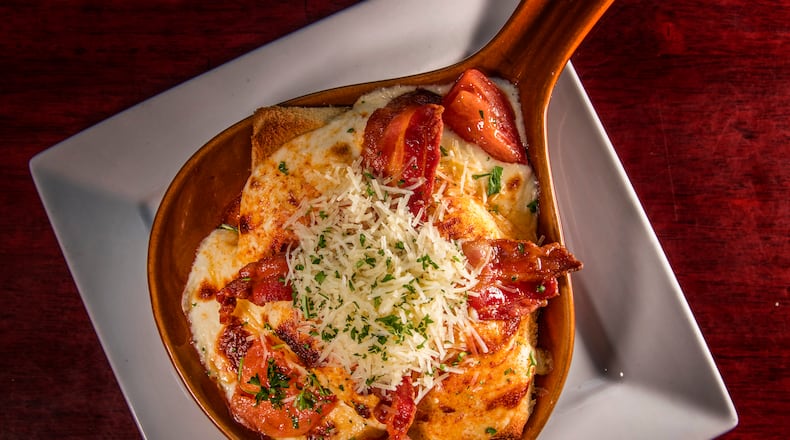LOUISVILLE, KY. — “For a dish to survive a hundred years still the same recipe is mind-blowing,” executive chef Gary Palm said on a recent afternoon in the opulent lobby of the Brown Hotel in Louisville, Kentucky.
Palm was, of course, talking about the hot brown, which originated at the hotel and has inspired myriad spinoff versions.
The history of the hot brown is intimately tied to the history of the hotel itself.
Built by businessman J. Graham Brown for $4 million, the Brown Hotel opened in 1923 at the bustling corner of Fourth Street and Broadway in the heart of Louisville. In its early years during the Roaring ‘20s, the hotel routinely attracted more than 1,000 people for its nightly dances.
Credit: Bill Dawers for The AJ
Credit: Bill Dawers for The AJ
To satisfy the late-night hunger of the partiers, chef Fred Schmidt in 1926 developed a hearty open-faced turkey sandwich with Mornay sauce, tomato, bacon and a handful of other ingredients. And the hot brown was born.
“It’s part of the foundation of the hotel,” Palm said. He considers the hot brown a “hotel heirloom.”
And it’s an heirloom that has been treasured despite dramatic changes to Louisville’s downtown landscape. The Brown Hotel survived Prohibition, the Great Depression and the devastating 1937 flood, but it closed for about a decade later in the 20th century.
Credit: Courtesy of the Brown Hotel
Credit: Courtesy of the Brown Hotel
When the hotel’s founder Brown died in 1969, he left most of his $100 million estate to a foundation that continues to have myriad positive impacts in Louisville. The hotel was sold to the public school system a few years later, but new owners restored and reopened it in the early 1980s.
Through the ups and downs, signature elements of the hotel remained intact, including the marble floors, the brass work, the hand-painted plaster ceiling in the second floor lobby – and the recipe for the hot brown.
A new steward of a Southern classic
Chef Palm grew up in modest means near Springfield, Massachusetts and credits his mother for teaching him the importance of self-sufficiency – ironing, sewing buttons, patching jeans and earning his own money for his first bicycle. He found his lifelong passion early on when he began working in restaurants.
“It was a fire inside me to keep learning cooking,” Palm said.
“It was a great building block for hard work, determination,” Palm said of his early days in kitchens where most of the employees spoke Chinese or Italian. “You pick up techniques, words, languages, work ethics. Now I don’t have an off button.”
Credit: Bill Dawers for The AJC
Credit: Bill Dawers for The AJC
Palm graduated from Johnson & Wales University, completed an apprenticeship in France and spent most of the next three decades working in restaurants and hotels around the world, including in Indonesia, India, South Korea and China.
“I was always learning,” Palm said, “whether it’s the culture, the people, understanding the food habits, understanding the cycle of food in each country.”
Eventually, Palm got tired of being an expat and wanted to share his knowledge with young people in the U.S. Since his return, his jobs have included serving as executive chef at Trump International Hotel & Tower in Chicago and Henderson Beach Resort and Spa in Destin, Florida.
Fluent in four languages and conversant in several others, Palm said that chefs have to wear many other hats throughout the day – businessman, artist, clairvoyant, human resources director, mentor and magician.
Palm came to the Brown Hotel in May and speaks passionately about new dishes on the menus, but he has a clear reverence for maintaining the tradition of the hot brown.
Other versions of the classic dish are easy to find on restaurant menus around Louisville, in cookbooks and on the web. Some recipes have cheddar or another cheese in the Mornay sauce. Some include ham. Some use slices of beefsteak tomatoes laid on top of the sandwich before cooking. Some have thinner slices of turkey and bread. And the list goes on.
But it’s easy to understand why so many locals and visitors continue to seek out the original. In Schmidt’s recipe, each of the main ingredients emerges with a distinct texture and flavor, despite the generous amount of Mornay sauce.
Tips for making a hot brown at home
In discussing his tips for home cooks, Palm emphasized the importance of understanding the flavor profiles and making good choices with each ingredient.
To retain as much moisture as possible, Palm suggests steaming the turkey breast. Cook the breast in a roasting pan with a 5-inch high rack and chicken stock in the bottom of the pan. Cover and cook over medium heat on the top of the stove, replenishing the liquid often, until the breast is 165 degrees. He advised against using leftover turkey, which is likely to be too dry.
Be sure to thickly slice the turkey to retain moisture and prevent the sauce from saturating the Texas toast.
Palm has only approved four members of his extensive staff to make the Mornay sauce, but he said that home cooks should not be intimidated by making it for the first time. They should follow the recipe closely, avoid turning up the heat too much and make sure the ingredients are well blended.
“And if all else fails: hello, YouTube,” Palm said. “Do you know how many things I fixed on my Harley watching YouTube?”
Palm said that the Roma tomatoes should be a uniform red and firm but not mushy. Bringing the tomatoes to room temperature before cooking will give them more flavor.
Gourmet delis and cheese shops might be the best places to try different brands of pecorino Romano, according to Palm. He said that he prefers a stronger flavor but that the cheese should not overwhelm the other ingredients.
“Anytime you cook, it’s like someone playing the orchestra leader,” Palm said. “You have different instruments, but you don’t want any one instrument to stand out more than anyone else, unless, obviously, they’re featured.”
“When you put a recipe together, you have to have the same kind of mentality.”
The Brown Hotel. 335 W. Broadway, Louisville, Kentucky. 888-888-5252, brownhotel.com.
Read about other Southern classic dishes and the chefs who are reimagining them at ajc.com/food-and-recipes/southern-classics-reimagined.
Credit: Bill Dawers for The AJC
Credit: Bill Dawers for The AJC
The World-Famous Hot Brown
2 ounces butter
2 ounces all-purpose flour
8 ounces heavy cream
8 ounces whole milk
½ cup pecorino Romano cheese plus 1 tablespoon for garnish
Pinch ground nutmeg
Salt and pepper
14 ounces roasted turkey breast, sliced thick
4 slices Texas toast, crust trimmed
4 slices crispy bacon
2 Roma tomatoes, sliced in half
Grated Parmesan cheese, for garnish
Paprika, for garnish
Parsley, for garnish
Make the Mornay sauce: In a two‑quart saucepan over medium-low heat, melt butter and slowly whisk in flour until combined and forms a thick paste (roux). Continue to cook roux for two minutes over medium‑low heat, stirring frequently. Increase heat to medium and whisk heavy cream and whole milk into the roux. Cook, whisking constantly, until the cream begins to simmer, about 2‑3 minutes. Remove sauce from heat and slowly whisk in pecorino Romano cheese until the Mornay sauce is smooth. Add nutmeg, salt and pepper to taste. Whisk until combined.
Assemble and cook two Hot Browns:
Heat the broiler with an oven rack positioned about 3 inches from the broiler.
Cut two slices of Texas toast in half, corner to corner, to make triangles. Leave the other two slices uncut. Place one square piece of toast in the center of two oven-safe dishes. Cover the square toasts with 7 ounces of turkey each. Place two toast triangles next to each side of the square toast. Top the triangles with Roma tomato halves.
Pour half of the Mornay sauce over each dish, completely covering the turkey and toast and partially covering the tomato. Sprinkle the top of each dish with 1/2 tablespoon pecorino Romano cheese. Place both dishes under the broiler until cheese begins to brown and bubble. Remove from broiler. Place two pieces of crispy bacon on top of each dish, garnish with a sprinkle of Parmesan cheese, paprika and parsley, and serve immediately.
Makes 2 hot browns.
Per serving: 1,713 calories (percent of calories from fat, 59), 103 grams protein, 75 grams carbohydrates, 11 grams total sugars, 2 grams fiber, 112 grams total fat (61 grams saturated), 458 milligrams cholesterol, 2,110 milligrams sodium.
Recipe courtesy of the Brown Hotel. Adapted and reprinted with permission.
Sign up for the AJC Food and Dining Newsletter
Read more stories like this by liking Atlanta Restaurant Scene on Facebook, following @ATLDiningNews on X and @ajcdining on Instagram.
About the Author
Keep Reading
The Latest
Featured







